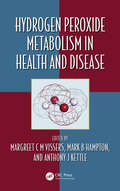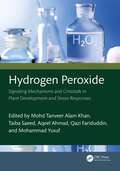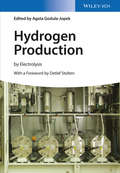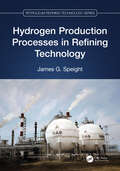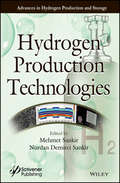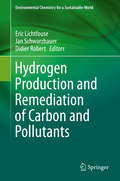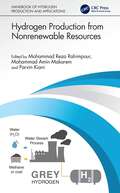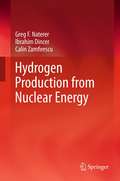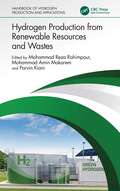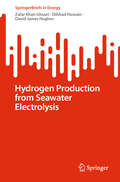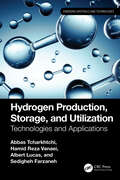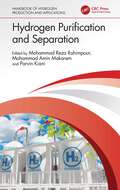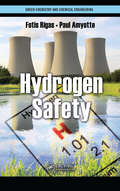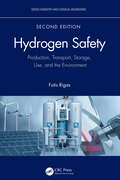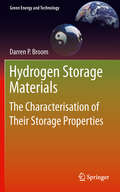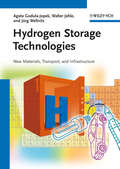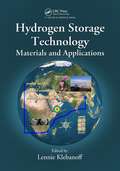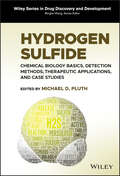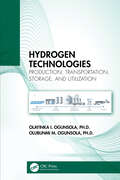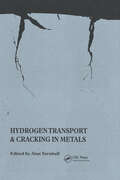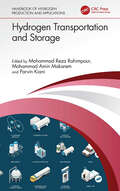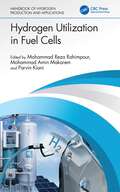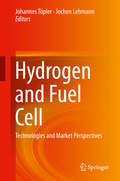- Table View
- List View
Hydrogen Peroxide Metabolism in Health and Disease (Oxidative Stress and Disease)
by Mark Hampton Margreet C Vissers Anthony J. KettleMuch of the biology of oxidative stress and oxidative signalling centres on the generation and handling of hydrogen peroxide. The overall aim for this book would be to provide an insightful and useful forum to assist with the understanding of the relevance of hydrogen peroxide generation and how this is managed in human biology. The target audience would be those who currently have an interest in the generation of ROS, but who do not have expertise in chemistry, as well as those experts in the chemistry of oxidative stress, but without detailed understanding of the biologically relevant setting. We would aim to bridge the gap in understanding between chemistry and biology.
Hydrogen Peroxide: Signaling Mechanisms and Crosstalk in Plant Development and Stress Responses
by Mohammad Yusuf Qazi Fariduddin Aqeel Ahmad Tanveer Alam Khan, Mohd Taiba SaeedHydrogen peroxide (H2O2) is recognized as a crucial signaling molecule that mediates physiological and biochemical processes in plants, regulating various development and stress responses. Hydrogen Peroxide: Signalling Mechanisms and Crosstalk in Plant Development and Stress Responses presents a comprehensive overview of hydrogen peroxide’s modes of action in plants demonstrating the important role played in plant stress signaling and communication. It introduces key topics in H2O2 research such as plant signaling, molecular responses, and interaction with other hormones.Features Discusses experiments interrelated to H2O2 signaling pathway in plants under various environmental conditions Addresses important concerns in H2O2 research from a wide range of organisms, including plants and prokaryotes such as bacteria and archaea Collects, summarizes, and presents developments in plant signaling and communication Aids scientists and breeders in developing strategies to enhance plant growth and stress tolerance Environmental stress is destructively disturbing plant growth and efficiency resulting in concerns to improve food crop yield, and H2O2 has immense field implications as it is vital in regulating plant growth and stress responses. Hydrogen Peroxide: Signalling Mechanisms and Crosstalk in Plant Development and Stress Responses is an invaluable resource for researchers and scientists to use as a guide to conduct studies on environmental conditions of the plant hydrogen peroxide signaling systems.
Hydrogen Production
by Agata Godula-Jopek Detlef StoltenCovering the various aspects of this fast-evolving field, this comprehensive book includes the fundamentals and a comparison of current applications, while focusing on the latest, novel achievements and future directions. The introductory chapters explore the thermodynamic and electrochemical processes to better understand how electrolysis cells work, and how these can be combined to build large electrolysis modules. The book then goes on to discuss the electrolysis process and the characteristics, advantages, drawbacks, and challenges of the main existing electrolysis technologies. Current manufacturers and the main features of commercially available electrolyzers are extensively reviewed. The final chapters then present the possible configurations for integrating water electrolysis units with renewable energy sources in both autonomous and grid-connected systems, and comment on some relevant demonstration projects. Written by an internationally renowned team from academia and industry, the result is an invaluable review of the field and a discussion of known limitations and future perspectives.
Hydrogen Production Processes in Refining Technology (Petroleum Refining Technology Series)
by James G. SpeightThis book details the various approaches to the production of hydrogen in petroleum refining. The need for hydrogen is addressed, and then the differences between the processes are detailed. This practical and accessible guide is written for managers, professionals, and technicians as well as graduate students transitioning into the refining industry.Key Features: Describes hydrogen purification methods and processes, providing relevant process data and fully describing process operations Describes hydrogen purification methods and processes, detailing the types of feedstock that can be used and exploring the options and parameters of each process Details commercial processes, including gasification pretreatment and reactions and considers next-generation processes and developments
Hydrogen Production Technologies
by Mehmet Sankir Nurdan Demirci SankirThe book is organized in three parts. Part I shows how the catalytic and electrochemical principles involve hydrogen production technologies. Part II is devoted to biohydrogen production and introduces gasification and fast pyrolysis biomass, dark fermentation, microbial electrolysis and power production from algae. The last part of the book is concerned with the photo hydrogen generation technologies. Recent developments in the area of semiconductor-based nanomaterials, specifically semiconductor oxides, nitrides and metal-free semiconductors based nanomaterials for photocatalytic hydrogen production are extensively discussed in this part.
Hydrogen Production and Remediation of Carbon and Pollutants
by Eric Lichtfouse Jan Schwarzbauer Didier RobertThis book details first the chemistry of hydrogen production from biomass. Solutions to the CO2 issue are given in three chapters, which describe CO2 photo catalytic reduction, CO2 sequestration in terrestrial biomass, and plants as renewable fuels. Further chapters review the selenium cycle in ecosystems, advanced processes to treat water and ecological ways to dye textiles. Society growth during the last century has almost entirely relied on the carbon economy, which is the use of fossil fuels for energy and materials. The carbon economy has provided and will still provide many benefits. However, the increasing use of fossil fuels is partly responsible for the increase of atmospheric CO2 concentrations and in turn, global warming. There is therefore an urgent need for cleaner fuels such as hydrogen, as well as a need for a carbon neutral economy where each emitted CO2 molecule is fast sequestered in plants, algae, soils, sub soils and sediments.
Hydrogen Production from Nonrenewable Resources
by Mohammad Reza Rahimpour Mohammad Amin Makarem Parvin KianiThe conventional generation of a substantial quantity of hydrogen from resources based on fossil fuels continues to play an essential role in the hydrogen economy. Hydrogen Production from Nonrenewable Resources offers a comprehensive overview and features three sections covering properties and characteristics of hydrogen, technologies for converting nonrenewable sources to hydrogen, and challenges in synthesis and production. Details of thermophysical characteristics and properties of hydrogen Covers conventional and novel industrial technologies for efficient production Explores environmental opportunities and challenges and health and safety regulations Provides techno‑economic and lifecycle assessments with future outlooks Part of the multivolume Handbook of Hydrogen Production and Applications, this standalone book guides researchers and academics in chemical, environmental, energy, and related areas of engineering interested in the development and implementation of hydrogen production technologies.
Hydrogen Production from Nuclear Energy
by Calin Zamfirescu Ibrahim Dincer Greg F. NatererWith the resurgence of nuclear power around the world, and the increasingly important role of hydrogen as a clean energy carrier, the utilization of nuclear energy for large-scale hydrogen production will have a key role in a sustainable energy future. Co-generation of both electricity and hydrogen from nuclear plants will become increasingly attractive. It enables load leveling together with renewable energy and storage of electricity in the form of hydrogen, when electricity prices and demand are lowest at off-peak hours of nuclear plants, such as overnight. Hydrogen Production from Nuclear Energy provides an overview of the latest developments and methods of nuclear based hydrogen production, including electrolysis and thermochemical cycles. Particular focus is given to thermochemical water splitting by the copper-chlorine and sulphur-based cycles. Cycle configurations, equipment design, modeling and implementation issues are presented and discussed. The book provides the reader with an overview of the key enabling technologies towards the design and industrialization of hydrogen plants that are co-located and linked with nuclear plants in the future. The book includes illustrations of technology developments, tables that summarize key features and results, overviews of recent advances and new methods of nuclear hydrogen production. The latest results from leading authorities in the fields will be presented, including efficiencies, costs, equipment design, and modeling.
Hydrogen Production from Renewable Resources and Wastes
by Mohammad Reza Rahimpour Mohammad Amin Makarem Parvin KianiThis book provides readers with a comprehensive overview of the processes and technologies utilized for producing hydrogen from renewable sources. It discusses common methods like gasification, pyrolysis, and liquefaction, along with novel methods like water thermochemical splitting, biophotolysis, biological water‑gas shift reaction, and fermentation processing. The application of various renewable sources, including wind, solar, and geothermal energy, is covered in detail. Introduces water splitting conversion processes for hydrogen production in detail Uniquely provides different pyrolysis, gasification, and liquefaction processes for hydrogen generation Covers different biomass and waste sources for producing hydrogen Discusses biochemical methods for converting biomass to hydrogen Provides the application of renewable energy sources in hydrogen production Part of the multivolume Handbook of Hydrogen Production and Applications, this standalone book guides researchers and academics in chemical, environmental, energy, and related areas of engineering interested in the development and implementation of hydrogen production technologies.
Hydrogen Production from Seawater Electrolysis (SpringerBriefs in Energy)
by Zafar Khan Ghouri Dilshad Hussain David James HughesThis brief provides an in-depth exploration of seawater splitting electrocatalysts, emphasizing critical challenges such as sustaining high current density, achieving oxygen evolution reaction (OER) selectivity, and utilizing earth-abundant materials. It offers insights into the current landscape of seawater electrolyzer technologies and emerging alternatives. The book also discusses rational design approaches aimed at developing highly active and stable electrocatalysts capable of industrial-scale current densities without degradation, with a focus on achieving selective oxygen evolution over chlorine evolution. Recent advancements in seawater electrocatalysts, including transition metal oxides, nitrides, sulfides, phosphides, and carbides, are examined. Additionally, it highlights promising strategies for electrocatalyst and electrolyzer design, as well as unconventional operating parameters. making it a valuable resource for graduates and researchers active in the fields of electrocatalysis and green technologies.
Hydrogen Production, Storage, and Utilization: Technologies and Applications (Emerging Materials and Technologies)
by Hamid Reza Vanaei Abbas Tcharkhtchi Albert Lucas Sedigheh FarzanehHydrogen Production, Storage, and Utilization: Technologies and Applications presents a comprehensive and in-depth exploration of the scientific and engineering principles of hydrogen technology. Written in a technical and scientific manner, using rigorous scientific language and mathematical models to explain principles and applications, the book covers various aspects of hydrogen technology, ranging from fundamental principles of thermodynamics and kinetics to practical applications of hydrogen production, storage, and utilization. Includes chapters on the latest advances in hydrogen production, including methods such as steam methane reforming, electrolysis, and biomass gasification Expresses the scientific principles of hydrogen storage, including metal hydrides, carbon-based materials, and liquid carriers Discusses the latest research on fuel cell technologies, including proton-exchange membrane fuel cells, solid oxide fuel cells, and microbial fuel cells Covers hydrogen safety aspects, including risk assessment, safety protocols, and safety standards Explores the challenges and opportunities associated with the deployment of hydrogen technology, including economic viability, environmental impact, and social acceptance The book is intended for scientists, engineers, researchers, and graduate students in the fields of chemical engineering, materials science, renewable energy, and sustainability, as well as policymakers and stakeholders interested in the potential of hydrogen as a clean and renewable energy carrier.
Hydrogen Purification and Separation
by Mohammad Reza Rahimpour Mohammad Amin Makarem Parvin KianiThe purification of hydrogen is necessary to fulfill purity standards of a wide variety of prospective uses, and it is also a key concern regarding the efficient supply of hydrogen. Hydrogen Purification and Separation reviews various hydrogen separation methods as well as membranes used in hydrogen separation. It discusses absorption and adsorption methods, as well as novel technologies such as cryogenic methods and plasma‑assisted technology, and the related economic assessments and environmental challenges. Introduces miscellaneous membrane‑assisted processes for hydrogen separation Provides different physiochemical absorption methods for hydrogen purification Discusses application of sorbents and swing technologies in hydrogen purification Uniquely covers hydrogen separation using novel methods Includes economic assessments and environmental challenges of hydrogen purification in detail Part of the multivolume Handbook of Hydrogen Production and Applications, this standalone book guides researchers and academics in chemical, environmental, energy, and related areas of engineering interested in development and implementation of hydrogen production technologies.
Hydrogen Safety (ISSN #13)
by Fotis Rigas Paul AmyotteHydrogen Safety highlights physiological, physical, and chemical hazards associated with hydrogen production, storage, distribution, and use systems. It also examines potential accident scenarios that could occur with hydrogen use under certain conditions. The number of potential applications for hydrogen continues to grow-from cooling power statio
Hydrogen Safety: Production, Transport, Storage, Use, and the Environment (ISSN)
by Fotis RigasWhile hydrogen is of vital and growing importance in many industrial sectors, this volatile substance poses unique challenges, including easy leakage, low ignition energy, a wide range of combustible fuel– air mixtures, buoyancy, and its ability to embrittle metals that are required to ensure safe operation. Updated to include the latest advances in the decade since original publication, Hydrogen Safety, Second Edition highlights physiological, physical, and chemical hazards associated with hydrogen production, storage, distribution, and usage systems. Focused on providing a balanced view of hydrogen safety – one that integrates principles from physical sciences, engineering, management, and social sciences – this book is organized to address questions associated with the hazards of hydrogen and the ensuing risks associated with its industrial and public use. This book: Addresses issues of inherently safer design, safety management systems, and safety culture. Features updated case studies of significant accidents involving hydrogen, along with their detailed analysis and lessons learnt, and potential accident scenarios under certain conditions. Details current research trends and perspectives on materials- based hydrogen storage solutions, hydrogen use in vehicles, and hydrogen in construction materials. Describes Process Safety Management as applied to the process industries, in conjunction with the components of the US Department of Energy Safety Plant Elements for hydrogen safety, and covers activities of the European Commission (EC) Network of Excellence for Hydrogen Safety (HySafe). Includes updated codes for gaseous and liquefied hydrogen and the NFPA 2 Hydrogen Technologies Code. Concludes with research and legal requirements. Offering a holistic view of hydrogen safety, from properties to safety systems, this book helps readers in chemical, industrial, safety, and related engineering subjects ensure a safe application and environment.
Hydrogen Storage Materials
by Darren P. BroomThe problem of storing hydrogen safely and effectively is one of the major technological barriers currently preventing the widespread adoption of hydrogen as an energy carrier and the subsequent transition to a so-called hydrogen economy. Practical issues with the storage of hydrogen in both gas and liquid form appear to make reversible solid state hydrogen storage the most promising potential solution. Hydrogen Storage Materials addresses the characterisation of the hydrogen storage properties of the materials that are currently being considered for this purpose. The background to the topic is introduced, along with the various types of materials that are currently under investigation, including nanostructured interstitial and complex hydrides, and porous materials, such as metal-organic frameworks and microporous organic polymers. The main features of Hydrogen Storage Materials include: an overview of the different types of hydrogen storage materials and the properties that are of interest for their practical use;descriptions of the gas sorption measurement methods used to determine these properties, and the complementary techniques that can be used to help corroborate hydrogen uptake data; andextensive coverage of the practical considerations for accurate hydrogen sorption measurement that drive both instrument design and the development of experimental methodology.Hydrogen Storage Materials provides an up-to-date overview of the topic for experienced researchers, while including enough introductory material to serve as a useful, practical introduction for newcomers to the field.
Hydrogen Storage Technologies
by Agata Godula-Jopek Joerg Wellnitz Walter JehleAn exploration of current and possible future hydrogen storage technologies, written from an industrial perspective. The book describes the fundamentals, taking into consideration environmental, economic and safety aspects, as well as presenting infrastructure requirements, with a special focus on hydrogen applications in production, transportation, military, stationary and mobile storage.A comparison of the different storage technologies is also included, ranging from storage of pure hydrogen in different states, via chemicalstorage right up to new materials already under development. Throughout, emphasis is placed on those technologies with the potentialfor commercialization.
Hydrogen Storage Technology: Materials and Applications
by Lennie KlebanoffZero-carbon, hydrogen-based power technology offers the most promising long-term solution for a secure and sustainable energy infrastructure. With contributions from the world's leading technical experts in the field, Hydrogen Storage Technology: Materials and Applications presents a broad yet unified account of the various materials science, physi
Hydrogen Sulfide and Plant Acclimation to Abiotic Stresses (Plant in Challenging Environments #1)
by M. Nasir Khan Francisco J. Corpas Manzer H. Siddiqui Saud AlamriThis book focuses on the role of hydrogen sulfide in the protection of plants against abiotic stresses and abiotic stress-induced complications by the way of converging advanced key methods of proteomics, genomics, and metabolomics. It provides an update on the biosynthesis, signaling, and mechanism of action of hydrogen sulfide in combating abiotic stresses in plants. Also, special emphasis is given to the interaction of hydrogen sulfide with other signaling molecules (such as nitric oxide, carbon monoxide, hydrogen peroxide etc.), phytohormones, mineral nutrients, ions, and ion channels in plants. This work, uniquely, covers key aspects of hydrogen sulfide signaling in relation to abiotic stresses in plants, including programmed cell death, stomatal movement, and fruit ripening.
Hydrogen Sulfide and its Therapeutic Applications
by Hideo KimuraThe metabolism of sulfur especially by sulfurtransferases had been intensively studied in mid 1900's. Three enzymes, cystathionine β-synthase (CBS), cystathionine γ-lyase (CSE) and 3-mercaptopyruvate sulfurtransferase (3MST) were found to have the capacity to produce H2S in vitro. However, H2S was recognized simply as a by-product of the metabolic pathways or as a marker for evaluating the activity of enzymes rather than as a physiological active molecule. In the late 1980's relatively high concentrations of sulfide were measured in the brain that led to the successive studies of identifying the physiological functions of H2S. Recently, the steady-state concentrations of H2S have been re-evaluated and found to be much less than that initially measured. However, despite these differences, such re-evaluations served to further confirm the existence of H2S in mammalian tissues. H2S is produced in almost every organ and plays various roles such as neuromodulation, vasodilation, insulin release, inflammation, angiogenesis and cytoprotection. The unregulated production of H2S and improper responses of target molecules are involved in the pathogenesis of various diseases. This book focuses on these topics as well as on the recent progress in the biology and the therapeutic development of this molecule.
Hydrogen Sulfide: Chemical Biology Basics, Detection Methods, Therapeutic Applications, and Case Studies (Wiley Series in Drug Discovery and Development)
by Binghe WangHYDROGEN SULFIDE Covers H2S interactions, methods of detection and delivery in biological environments, and a wide range of applications Research on hydrogen sulfide (H2S) spans diverse disciplines including chemistry, biology, and physiology. In recent years, new materials and approaches have been developed to deliver H2S and related reactive sulfur species in various clinical contexts. Although many biological pathways involving H2S are complex, all are governed by fundamental chemical interactions between reactive sulfur species and other molecular entities. Hydrogen Sulfide: Chemical Biology Basics, Detection Methods, Therapeutic Applications, and Case Studies provides the foundation required for understanding the fundamental chemical biology of H2S while highlighting the compound’s therapeutic potential and medicinal applications. This book covers key aspects of H2S chemical biology, including the fundamental chemistry of reactive sulfur species; the measurement, detection, and delivery of H2S in biological environments; and the therapeutic and medicinal uses of exogenous H2S delivery in various pharmacologically relevant systems. Throughout the text, editor Michael Pluth and chapter contributors discuss the opportunities and future of the multidisciplinary field. Provides approaches for delivering H2S with relevance to biological and therapeutic applications Describes complex interactions of H2S with bioinorganic complexes and reactive sulfur, nitrogen, and oxygen species Summarizes advances in available tools to detect, measure, and modulate H2S levels in biological environments, such as real-time methods for H2S fluorescence imaging in live cell and animal systems Helps readers understand known systems and make connections to new and undiscovered pathways and mechanisms of action Includes in-depth case studies of different systems in which H2S plays an important role Hydrogen Sulfide: Chemical Biology Basics, Detection Methods, Therapeutic Applications, and Case Studies is an important source of current knowledge for researchers, academics, graduate students, and industrial scientists in the fields of redox biology, hydrogen sulfide research, and medicinal chemistry of small biological molecules.
Hydrogen Technologies: Production, Transportation, Storage, and Utilization
by Olayinka I. Ogunsola Olubunmi M. OgunsolaOffering a wide-range coverage, this book provides fundamentals as well as the applied science and technology involved in the whole hydrogen value chain, including production, storage, transportation, and utilization. It discusses some challenges and opportunities for hydrogen to address energy demand and climate change issues.Features: Discusses various technology pathways for manufacturing/producing hydrogen both directly (i.e., water splitting) and indirectly (i.e., gas, conversion of coal, and biomass). Covers techniques and technologies for transporting gaseous, liquid, solid, and other forms of hydrogen, including mobile and stationary modes as well as small- and large-scale forms of transportation. Offers techniques and technologies for storing hydrogen with emphasis on materials and physical and chemical characteristics. Describes hydrogen utilization in energy/energy conversion, industrial chemical, industrial agricultural, and transportation sectors. This book is aimed at engineers and scientists working in the disciplines of energy, chemical, environmental, petroleum, petrochemical, and mechanical engineering.
Hydrogen Transport and Cracking in Metals: Proceedings of a Conference Held at the National Physical Laboratory, Teddington, UK, 13-14 April 1994
by Alan TurnbullProceedings of a Conference Held at the National Physical Laboratory, in Teddington, UK, on the 13-14 April 1994, with the main focus of Hydrogen Transport and Cracking in Metals.
Hydrogen Transportation and Storage
by Mohammad Reza Rahimpour Mohammad Amin Makarem Parvin KianiThe success of hydrogen energy markets depends on developing efficient hydrogen storage and transportation methods. Hydrogen may be stored in various ways, including compression, liquefaction, adsorption, hydrides, and reformed fuels. Hydrogen’s application, transport method, storage time, and other factors all have an impact on the technology choices available for its long‑term storage. This book comprehensively reviews hydrogen storage and transportation technologies along with related safety hazards and challenges. Introduces hydrogen storage and transportation materials and standards Includes miscellaneous hydrogen storage methods Covers different hydrogen transportation technologies Comprehensively describes hydrogen storage and transportation safety considerations Provides economic assessments and environmental challenges related to hydrogen storage and transportation Part of the multivolume Handbook of Hydrogen Production and Applications, this standalone book guides researchers and academics in chemical, environmental, energy, and related areas of engineering interested in development and implementation of hydrogen production technologies.
Hydrogen Utilization in Fuel Cells
by Mohammad Reza Rahimpour Mohammad Amin Makarem Parvin KianiHydrogen Utilization in Fuel Cells introduces the fundamentals, characteristics, and applications of fuel cells, materials used, the role of hydrogen in different fuel cell types, and applications of fuel cells in transportation and small portable and stationary power systems. Introduces the electrochemistry and thermodynamics of fuel cells Provides an overview of fuel cells materials Discusses applications of fuel cells in transportation and energy systems Describes the role of hydrogen in various fuel cells Details the kinetics, performance, stability, and environmental challenges of fuel cells Part of the multivolume Handbook of Hydrogen Production and Applications, this stand-alone book guides researchers and academics in chemical, environmental, energy, and related areas of engineering interested in development and implementation of hydrogen production technologies.
Hydrogen and Fuel Cell
by Johannes Töpler Jochen LehmannThis book introduces readers to hydrogen as an essential energy carrier for use with renewable sources of primary energy. It provides an overview of the state of the art, while also highlighting the developmental and market potential of hydrogen in the context of energy technologies; mobile, stationary and portable applications; uninterruptible power supplies and in the chemical industry. Written by experienced practitioners, the book addresses the needs of engineers, chemists and business managers, as well as graduate students and researchers.
